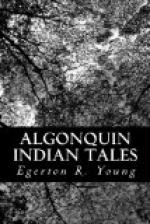Nothing gave the children greater pleasure than to have permission to go with Mary and Kennedy in a large roomy birch canoe for a moonlight excursion during one of those warm, brilliant nights. With plenty of rugs or cushions, to make the coziest of seats in the center of the canoe, they fairly reveled in the beauties of the romantic surroundings while they floated on the moonlit lake. Often in some place of more than ordinary beauty Kennedy would cease paddling, and then their very quietness added to the charms of those happy outings.
[Illustration: With Mary and Kennedy in the birch canoe.]
“Say, Mary,” said Sagastao, “I was reading in one of my books about the ‘man in the moon.’ Do you know anything about him?”
“He is looking at us very kindly to-night,” said Minnehaha. “I really believe I saw him laughing, he is so pleased we have come out to see him this lovely night.”
These remarks of the children caused all in the canoe to more closely scan the great round moon that was shining with silvery whiteness straight in front of them.
“There are lots of stories about the moon among our people,” said Mary, “but not a great many about the man in the moon. There is, however, a queer one about how he came down and helped a poor orphan boy.”
“O, tell it to us just now,” said Minnehaha, “while he is watching and listening.”
“Do, Mary,” said Sagastao, “and Minnehaha and I will watch the old fellow and see how he likes to be talked about.”
“Well,” said Minnehaha, “Mary will be talking to him to his face, and not behind his back, as people sometimes do when talking about others.”
Thus the children ran on with their prattle. Mary and Kennedy were much amused.
“Come, Mary, hurry up! Father said the gloaming would end about eleven, and we must be at the shore by that time.”
“Pretty late hours for little children,” said Kennedy.
“Never mind that,” said Sagastao; “we will make up for it in winter time, when it gets dark at four o’clock.”
With Sagastao on one side of her in the big canoe and Minnehaha on the other—their favorite positions when listening to her fascinating stories as she crooned them out in her soft, musical Cree—Mary told them the story.
“Long ago,” she began, “there was a poor orphan boy who had neither father nor mother, uncle, aunt, nor any living relative that he knew of. He had a very hard time of it, as the people did not seem to take kindly to him. So he had to live just where he could. He managed to get along all right during the pleasant summer time, but when the long cold winters began he suffered very much. One winter some selfish people let him live with them because he was willing to work hard for what little they did for him. They treated him badly in many ways. They made him go out into the woods and cut firewood, but when he brought it home they would only allow him to stay in the cold entry-way which they had built to their winter dwelling.




